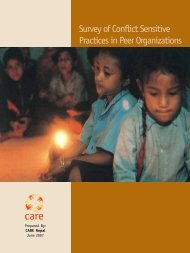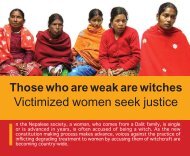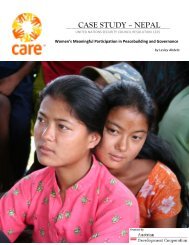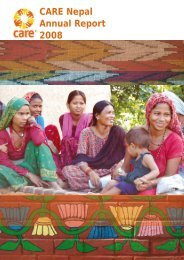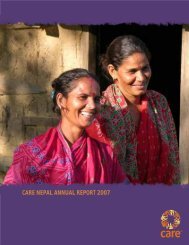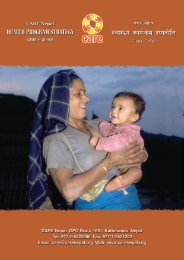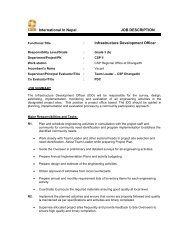Untitled - Care Nepal
Untitled - Care Nepal
Untitled - Care Nepal
Create successful ePaper yourself
Turn your PDF publications into a flip-book with our unique Google optimized e-Paper software.
and snowballing sampling techniques were<br />
applied. Moreover, proportional sampling<br />
method was applied for free-listing<br />
according to the population in the<br />
respective community. Certain selection<br />
criteria were developed to identify the<br />
participants for study.<br />
Table 1: Selection Criteria<br />
Instruments<br />
Key Informant Interviews<br />
Representative of women groups or mothers groups<br />
Teachers (2 Female, 2 Male)<br />
Community Leaders and Health Workers<br />
Service Providers<br />
Security Forces<br />
Focus Group Discussions<br />
Landless women<br />
Women aged (35-45)<br />
Men aged (35-45)<br />
Young girls (12-18)<br />
Dalit and Janajati<br />
Brahmin and Chettri<br />
Single women (whose husbands had died)<br />
SELECTION<br />
PROCEDURE<br />
1. KII and FGD<br />
• Researchers moved around and<br />
met with different people in the<br />
communities<br />
• Research objectives were described very<br />
clearly<br />
• Researchers asked the people in the<br />
community for eligible key informants<br />
of different groups such as teachers and<br />
health workers, who could provide<br />
enrich information about the issues of<br />
women in their community<br />
Case Studies<br />
Women who were coping with their problems<br />
Women still having problems<br />
Free-listing and Prioritization<br />
Dalit 25%<br />
Janajati 50%<br />
Madhesi 10%<br />
Others 15%<br />
• Visited the home or place where key<br />
informants were available.<br />
• Developed rapport and discussed the<br />
contents of the consent form<br />
• After getting consent from him or her,<br />
started the interview or discussion in<br />
an informal way<br />
2. Case Studies<br />
• Researchers tried to identify the<br />
women, most appropriate for the case<br />
studies while conducting KIIs and<br />
FGDs.<br />
• If researchers were not able to find<br />
respondents for case studies then they<br />
12<br />
Psychosocial Issues of<br />
Women affected by conflict



